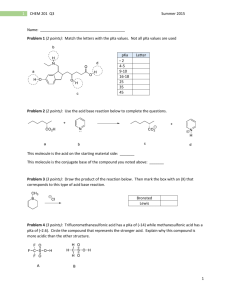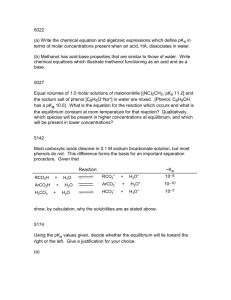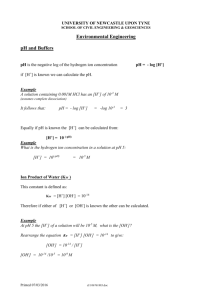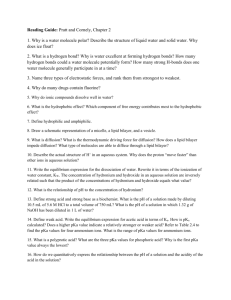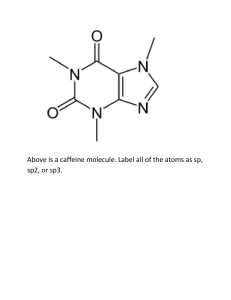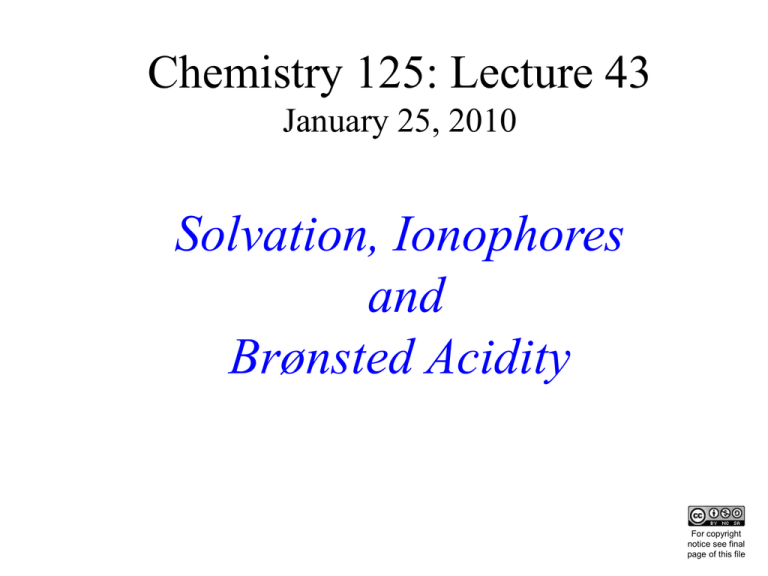
Chemistry 125: Lecture 43
January 25, 2010
Solvation, Ionophores
and
Brønsted Acidity
This
For copyright
notice see final
page of this file
Text Section 6.10
Crown Ethers and
Tailored Ionophores
Nobel Prize
in Chemistry
1987
“ion carriers”
18-c-6
>1/2 complexed 1,150,000 Relative binding constants
at 1 M [18-c-6]
29106 stronger
than MeOH !
H
-13.4
for 18-crown-6 with various
alkali metal ions
in MeOH at 25°C
0.79 g/ml
-TS
5.2
kcal/mole
-8.4
23,000
2.5
mol.wt. 32
25 molar
K=
[M+•18-c-6]
[M+]
[18-c-6]
(mol-1)
Phase-Transfer Catalysis
By making cation large 18-c-6 “destabilizes” solid or aqueous KMnO4
allowing the salt to dissolve in hydrocarbons. (“purple benzene”)
organic
substance
to oxidize
organic
solvent
H2O
KMnO4
Similar effect from
adding other salts with
large organic cations,
e.g.
R4N+ ClR4P+ Cl-
Avoids need for expensive,
dangerous solvents
like (CH3)2SO
that dissolve both reagents
Cryptands
Nonactin
a bacterium-generated
antibiotic
Nonactin
QuickTime™ and a
H.264 decompressor
are needed to see this picture.
Keq (MeOH)
Na+
512
K+ 31,000
moves K+ selectively
through a membrane
The Importance of Solvent for Ionic Reactions
E±Coulomb = -332.2 / dist (Å) [long-range attraction; contrast radical bonding]
kcal/mol
400
300
H+
+
OH-
392
(g)
H+ :OH2 bonding
plus close proximity
164 !
of + to eight electrons e transfer
OH- (aq)
similar
(polarizability shifts e-cloud)
H3O+ (g)
etc,
etc,
etc
106
28
Sum = 370
18
200
100
From small difference of
H3O+ (aq)
100
0
-(3/4 386) 10-290
K(G) 10
BDE HO-H 120
H2O (g)
H2O (aq)
6.3
21.5
large numbers!
pKa = 15.8
H+(aq) + OH-(aq)
Fortunately solvation energies of
analogous compounds are similar
enough that we can often make
reasonably accurate predictions
(or confident rationalizations)
of relative acidities in terms of
molecular structure.
When pKa = pH
Why should organic chemists bother about pH and pKa, which seem like
topics for general chemistry?
a) Because whether a molecule is ionized or not is important for
predicting reactivity (HOMO/LUMO availability), conformation, color,
proximity to other species, mobility (particularly in an electric field), etc.
b) Because the ease with which a species reacts with a proton might
predict how readily it reacts with other LUMOs (e.g. *C-X or *C=O).
[H+] [B-]
Ka =
[HB]
[B-]
pKa = pH - log
[HB]
= pH, when HB is half ionized
Single indicators work best over ~2.5 pH units (95:5 - 5:95).
Bootstrap with overlapping indicators for wide coverage.
Factors that Influence Acidity
16
HOH
15.7
(BDE 119)
12
pKa *
+
H3NH
9.2
HSH
7.0
(BDE
FH
3.2
(BDE 136)
8
91)
4
0
+
H2OH
-4
-1.7
Learning from
pKa Values
Brønsted Acidity
Chapter 3
BDE 105
108
119
136
91
103
88
71
Overlap!
16
HOH
Learning from
pKa Values
15.7
12
pKa *
+
O
H3NH
9.2
HSH
7.0
9
8
4
3.2
0
+
H2OH
-4
-1.7
CH3-C-CH-C-CH3
H
O
4.8
FH
O
2.9
CH3-COH
O
ClCH2-COH
CH3O
H3NCH-COH
+
http://themedicalbiochemistrypage.org/images/titrate.jpg
Titration of Alanine
Approximate “pKa” Values
50
CH3-CH2CH2CH2H ~ 52
pKa *
40
CH3-C C-CH2H
CH3-CH=C=CHH
(best E-match C-H)
sp2 C_ (no overlap)
:
CH3-CH2CH=CHH ~ 44
_
sp3 C
_
(allylic)
C HOMO - overlap
(better E-match N-H)
~ 34 H2NH
~ 38
30
CH3-CH2C CH : ~ 25
sp C_ (no overlap)
20
= 16 HOH
10
(bad E-match O-H)
* Values are approximate because HA1 + A2- = A1- + HA2 equilibria
for bases stronger that HO- cannot be measured in water. One must
“bootstrap” by comparing acid-base pairs in other solvents.
1st of 6 pages from
http://evans.harvard.edu/pdf/evans_pKa_table.pdf
Problems for Wednesday:
1) List factors that help determine pKa for an acid.
2) Choose a set of several acids from the Ripin-Evans
Tables or from the text (inside back cover) and
explain what they teach about the relative
importance of these factors.
3) Explain your conclusions to at least one other class
member and decide together how unambiguous
your lesson is.
Feel free to consult a text book and its problems
or the references at the end of the Tables.
Hint: this could provide a good question.
End of Lecture 43
Jan. 25, 2010
Copyright © J. M. McBride 2010. Some rights reserved. Except for cited third-party materials, and those used by visiting
speakers, all content is licensed under a Creative Commons License (Attribution-NonCommercial-ShareAlike 3.0).
Use of this content constitutes your acceptance of the noted license and the terms and conditions of use.
Materials from Wikimedia Commons are denoted by the symbol
.
Third party materials may be subject to additional intellectual property notices, information, or restrictions.
The following attribution may be used when reusing material that is not identified as third-party content:
J. M. McBride, Chem 125. License: Creative Commons BY-NC-SA 3.0

